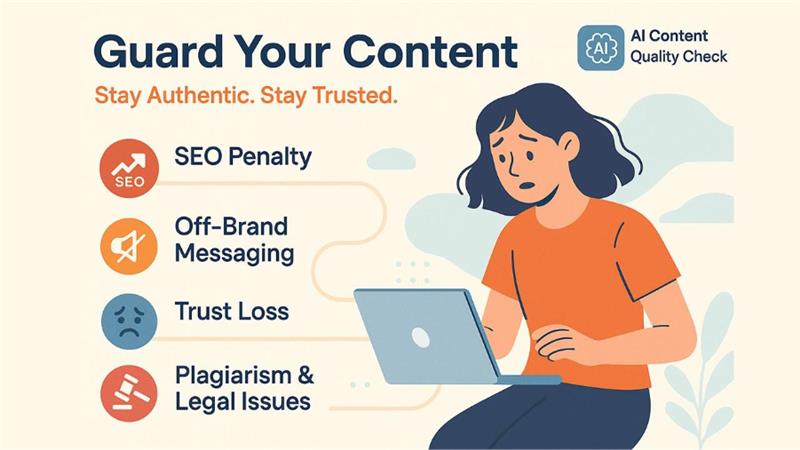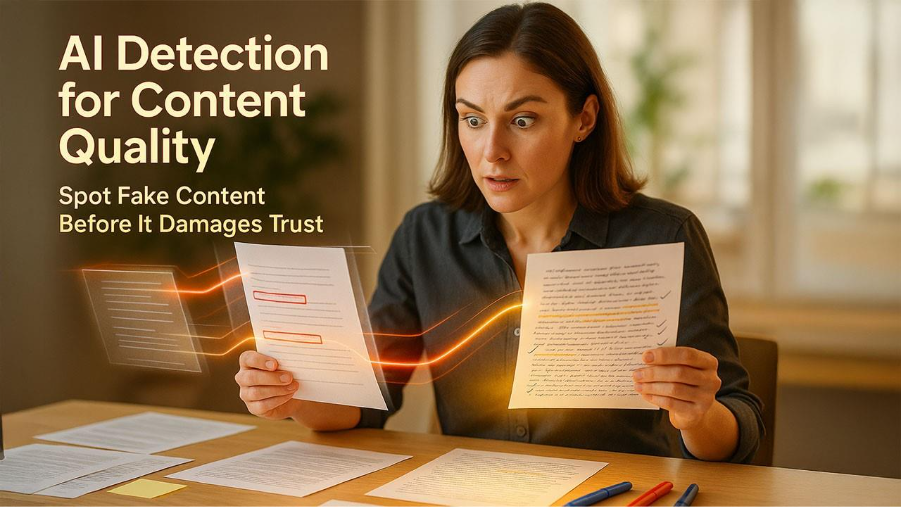With the rise of automation, content creation is advancing faster than ever, but this also carries hidden risks. AI tools can write an entire blog post, email, or report in a matter of seconds. While this is beneficial for businesses to get things done faster, it can also create ambiguity between original human content and machine-generated text.
For that reason, more companies are beginning to take active steps to identify AI writing and verify the integrity of the written content before publishing. Whether you are managing CRM templates, customer-facing content, or outsourced articles, it is essential to have ways to verify whether content is AI-generated so that you can continue to maintain your brand's credibility and SEO performance.
Why AI Detection Matters for Modern Businesses
AI content is not necessarily bad. AI is used for many purposes such as brainstorming, drafting, or speeding up repetitive writing tasks by teams. But problems arise when:
- AI-generated content is published without any editing.
- SEO struggles due to generic and low-quality content.
- Product or support materials become inaccurate or vague.
- Instead of original work, freelancers deliver AI copied content.
For businesses that rely on CRM, especially those that focus on automation and customer engagement, all content must be authentic across all channels, including email, knowledge bases, chat scripts, and marketing copy.
Key Risks of Unchecked AI-Generated Content

If your content pipeline includes AI-generated content or content created by someone else, here are the issues that can arise if content is not audited:
1. SEO Penalties
Search engines, such as Google, penalize content that is not original, helpful, and written for humans. If you consistently use material that has been written by AI and lacks depth, it can harm your rankings. To avoid this, you can review your content with an AI checker to ensure it reads naturally and meets quality standards.
2. Generic or Off-Brand Messaging
In addition, AI writing is known for being flat, repetitive, and too formal. All of which lack human touch. AI copy often misrepresents your brand's tone and customer expectations.
3. Loss of Customer Trust
Vague or incorrect responses in your CRM system, help desk, or product documentation will leave customers frustrated and damage loyalty.
4. Plagiarism and Legal Issues
Some outputs of AI could potentially copy other existing content or make unverified claims that will expose your business to liability.
What an AI Detector Does and Why You Need One
Artificial Intelligence detection tools can read text and identify markers that may signify this text was generated by a language model like GPT. These tools look at patterns for:
- Overuse of transitional phrases
- Predictable structure
- Lack of specific details
- Robotic tone or repetition
The most helpful tools give a confidence score which would allow you to decide whether or not the content is worthy of correcting or editing. Once flagged, you can choose to rewrite the content from scratch or humanize AI text to add authenticity, personality, and brand voice that aligns with your standards. Using such tools could be an easy way to assess content's originality and avoid publishing questionable content.
Practical Use Cases for CRM-Driven Teams
Here’s how businesses are applying AI detection tools to their daily operations:
• Verifying CRM Email Templates
If your team relies on AI to write or update automated email templates, one of the best ways to maintain engagement and tone is to identify low-quality or robotic text prior to sending.
• Evaluating Outsourced Marketing Content
Many businesses hire writers or freelancers for product pages, newsletters, or blog posts. AI detectors help ensure you’re getting original, value-driven work — not lazy AI outputs.
• Auditing Knowledge Base Articles
Knowledgeable product articles or help center articles written using AI can lose clarity and accuracy. Using an AI detector helps safeguard clarity and quality.
• Screening Job Applications
HR teams can use detection to flag resumes or cover letters written entirely by AI to distinguish high-quality applicants. It supports better hiring decisions.
Boosting SEO with Human-Like, Quality Content
Search engines reward those content that show Experience, Expertise, Authoritativeness, and Trustworthiness (E-E-A-T). AI tools generate content faster, but it often includes filler content that lacks insight or specific details.
Using a detection step before publishing helps businesses in the following ways:
- Increase search engine visibility.
- Reduce bounce rates from content that is not engaging.
- Ensure content offers real value.
- Align content so it resonates with the audience’s needs.
If your SEO plan consists of large-scale content publishing, detection tools are your safety net that filter out low-quality or low-value content.
AI Isn’t the Problem — Lack of Oversight Is
There is nothing wrong with using AI tools to support your content creation. Blindly trusting is the problem. Detection works to keep humans accountable for the final output - adding context, expertise, and voice where it matters most.
Think of it as part of your content quality assurance process. Just like spell check or plagiarism detection, AI detection is becoming another step for modern teams approving the quality content.
The ability to check for AI writing is no longer optional — it is an essential part of adequately managing your content in a digital first world. If your team is managing CRM workflows, producing thought leadership content, or communicating with customers, verifying the content they are producing is an essential step to protect your business from the adverse effects of:
- Damaged Reputation
- SEO decline
- Legal liability
- Loss of trust
Integrating a simple AI detection tool into your workflow not just helps you capture bad content but also raises standards for everything your brand communicates.


